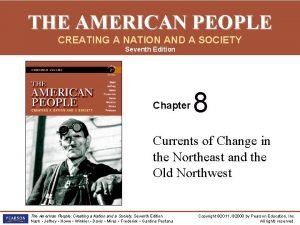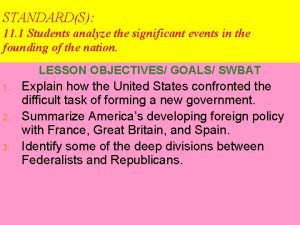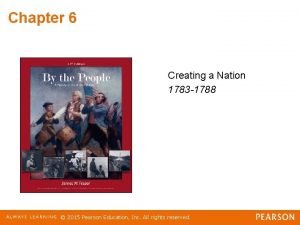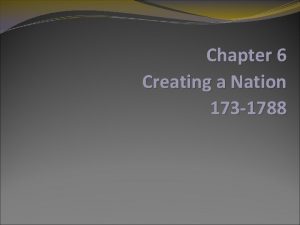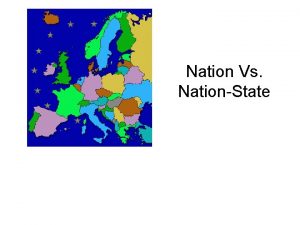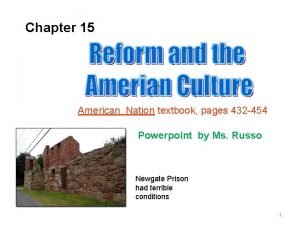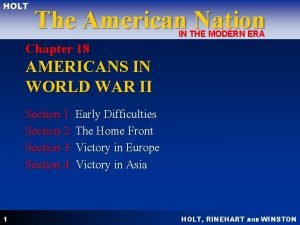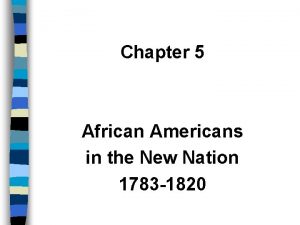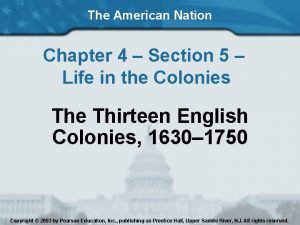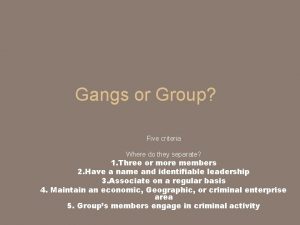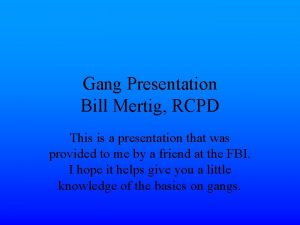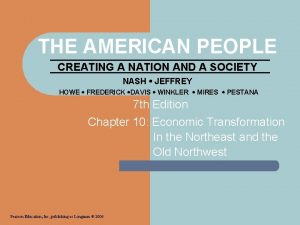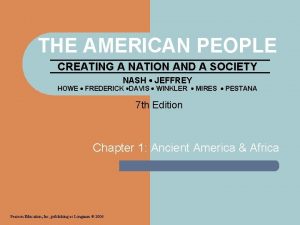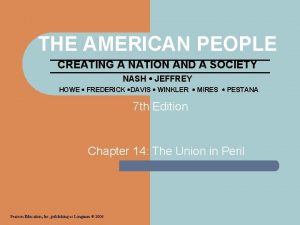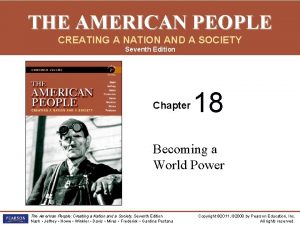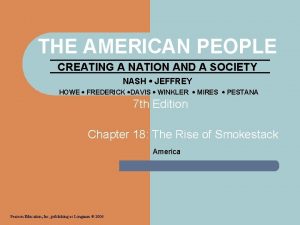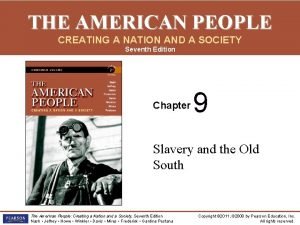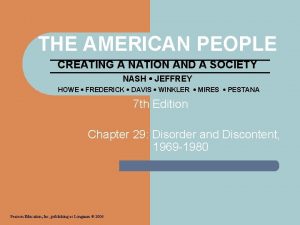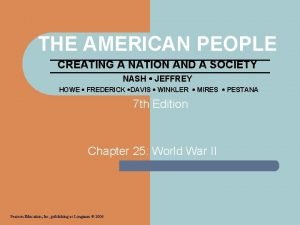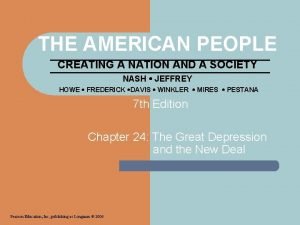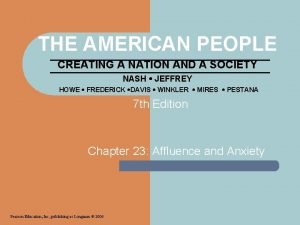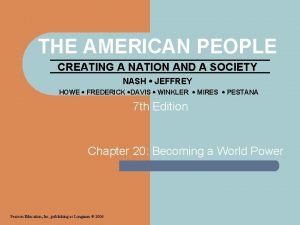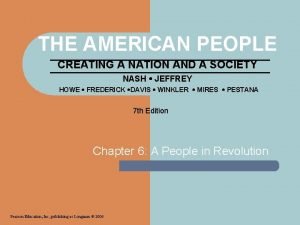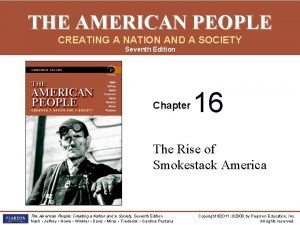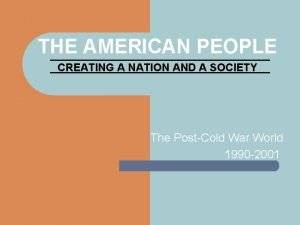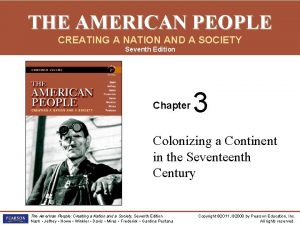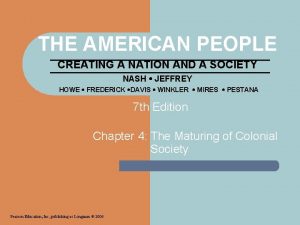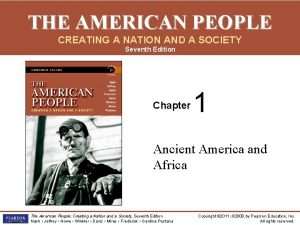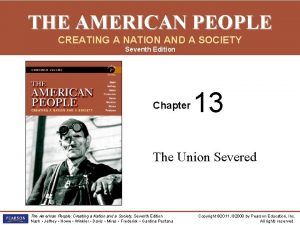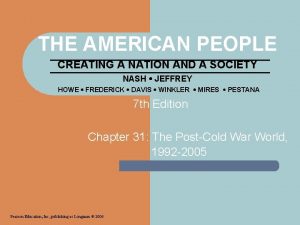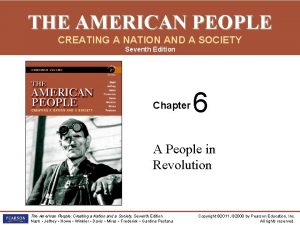THE AMERICAN PEOPLE CREATING A NATION AND A
















































- Slides: 48

THE AMERICAN PEOPLE CREATING A NATION AND A SOCIETY NASH JEFFREY HOWE FREDERICK DAVIS WINKLER MIRES PESTANA 7 th Edition Chapter 26: Postwar America at Home, 1945 -1960 Pearson Education, Inc, publishing as Longman © 2006

ECONOMIC BOOM l l l Most Americans were optimistic after 1945 A baby boom brought unprecedented population growth Large corporations dominated the business world – – Labor unions grew as well Technology appeared triumphant

THE THRIVING PEACETIME ECONOMY l The years following World War II saw one of the longest sustained economic expansions in the history of the U. S. – – – l The automobile industry played a key role in the expansion – – l l Millions of cars were quickly produced Development of a massive interstate highway system, encouraged by the Interstate Highway Act of 1956, also stimulated production Housing boom, fueled by the 1944 GI Bill, further encouraged growth with housing ownership reaching 62 percent in 1960 Government’s increasingly active economic role both stimulated and sustained expansion – – l Gross National Product (GNP) jumped dramatically as did per capita personal income Personal resources fueled economic growth Equally important was 22 percent rise in real purchasing power between 1946 and 1960, with three out of every five families having discretionary income by 1960 Businesses could buy new factories built during war at less than they cost Defense spending rose, especially after the 1947 National Security Act created the Department of Defense Inflation remained low and the number of middle-class Americans increased


U. S. Interstate Highway System

POSTWAR GROWTH AROUND THE WORLD l l Much of Europe had been devastated by the war British factories were inefficient and outdated – – l France experienced a rising birthrate at home while abroad its colonies demanded independence – l l Colonial struggles caused financial instability and undermined economic development U. S. decided a strong West Germany was necessary and helped finance the rebuilding of German factories – l General election of 1945, Churchill was replaced by the Labour Party which took over the coal and railroad industries and began to nationalize the steel industry Provided a system of socialized medicine High Commission provided economic aid, scaled down German debt and eliminated controls over German industry all contributing to huge German growth Japan also revived quickly under the reconstruction efforts headed by General Douglas Mac. Arthur Soviets also worked on rebuilding

THE CORPORATE IMPACT ON AMERICAN LIFE l Industrial combination continued after the war making oligopoly a feature of American capitalism – – – Booming economy encouraged the development of conglomerates Smaller franchise operations also grew Large corporations moved into foreign markets and began to build plants overseas where labor was cheaper

CHANGING WORK PATTERNS l l l At this point in history, the United States stopped being primarily a goods producer and began a new path as a service provider The growing number of white collar employees worked in increasingly impersonal and bureaucratic conditions that stressed conformity Blue collar assembly line workers were more comfortable as union movement brought substantial gains – Perhaps 40 percent of the work force failed to benefit from this because they worked less appealing, less well-paying positions


THE UNION MOVEMENT AT HIGH TIDE l At the end of WWII there were 14. 5 million union members, with 10 million belonging to the AFL and the rest to the CIO – l Post-war disruptions resulted in strikes that alienated the middleclass and outraged conservative republicans In late 1940 s a new equilibrium emerged as many industries recognized the basic rights of industrial workers while the union acknowledged the prerogatives of management and accepted the principles of fair profit – – – Corporations in the same industry agreed to cooperate rather than compete with one another over labor costs Companies made material concessions to workers such as cost-ofliving adjustments (COLA), pensions, annual wages AFL and CIO merged in 1955

AGRICULTURAL WORKERS IN TROUBLE l l l On the eve of WWII, agriculture had supported one in five but after the war the figure fell to one in 20 as 15 million rural jobs disappeared New technology revolutionized farming Increasing profitability led to agricultural consolidation – – – Farm size doubled and farms specialized more in cash crops that were more profitable Farms demanded more investment and became big business Midwestern whites who left the farm often found jobs in factories and offices while African Americans had more trouble when they moved north to the cities

DEMOGRAPHIC AND TECHNOLOGICAL SHIFTS l l Population grew dramatically and continued to move west while millions of white Americans left the cities for the suburbs New patterns, revolving around television and other gadgets, came to characterize the consumer culture that dominated suburban life

POPULATION GROWTH l l Birthrate exploded after WWII even as the death rate declined, in part due to advances in medication Baby boom shaped family patterns as women returned to the home to care for their families – – Demand grew for diaper services and baby foods As the kids reached school age, they strained the educational system which needed new classrooms and teachers


MOVEMENT WEST l Postwar American became more mobile than ever before and generally headed west – – Mobility spread to the middle class Cities throughout the Sunbelt South and West coast saw enormous growth as Americans who had been stationed in these areas returned after the war or came for jobs in the growing defense industry or the service economy

The Great Los Angeles Area in the 1950 s

Population Shifts, 1940 -1950

THE NEW SUBURBS l Population also shifted away from the traditional city centers to outlying suburbs where housing was cheaper – – l Levitt claimed suburban homes underscored American values – l Central cities became places where poor nonwhites clustered By the end of the 1950 s, one-third of all Americans resided in suburbs especially in the mass produced houses in places such as Levittown Refused to sell homes to blacks Government ensured mortgages and low postwar interest rates fueled the housing boom – – Suburbanization transformed the American landscape Businesses followed people to the suburbs


THE ENVIRONMENTAL IMPACT l l Rapid expansion took place without extensive planning and led to what one writer called “uglification” of the countryside With more leisure time, Americans began to explore nature and think about protecting it – 1958 Congress established the National Outdoor Recreation Review Commission

TECHNOLOGY SUPREME l A technological revolution transformed postwar America often as a direct result of war research – – – l Development of the computer started with large, room-filling calculating machines and was transformed by the creation of the transistor – – – l Government established National Institutes of Health in 1948 and National Science Foundation in 1950 The Atomic Energy Commission and the Department of Defense provided rapidly increased funding for research and development Money went to large research universities and fueled their growth Computers contributed dramatically to the centralization and interdependence to American life Computers were essential for space exploration Transistors powered not only computers but also a wide variety of new appliances and gadgets designed for personal use Computerization led to the advent of automation

THE CONSUMER CULTURE l By the end of the 1950 s, most families had at least one car plus a variety of staple appliances – l Television became a major influence on American life – l Elvis Presley, Bill Haley and the Comets, Chuck Berry, Little Richard Consumption required a vast expansion of consumer credit – l Average family tuned in four or five hours each day Television highlighted the rock-and-roll music that developed in the 1950 s – l Dozens of less-essential items also became possible Diner’s Club appeared in 1950, followed at the end of the decade by American Express and Bank. Americard (VISA) Revitalized advertising industry encouraged purchases


CONSENSUS AND CONFORMITY l l An increasing sense of sameness pervaded society As immigration slowed after 1924, ties to Europe weakened and assimilation speeded up – – Interethnic marriage skyrocketed Television provided a shared, visually seductive experience

CONTOURS OF RELIGIOUS LIFE l l Postwar Americans discovered a shared religious sense and by the end of the 1950 s, 95 percent of Americans identified with some religious denomination Ecumenical activities promoted greater religious involvement – – – l Religious revival drew in part on the power of suggestion as well as offering a means of escape from the anxieties of a middle-class executive’s life – l Evangelical revivalism, led by Billy Graham and others, became increasingly popular Catholicism broadened its appeal after Pope John XXIII convened the Vatican Ecumenical Council in 1962 to make the church’s traditions and practices more accessible Judaism also broadened its appeal and Jews began to fit into society more 1954 Congress added “under God” to the Pledge of Allegiance and, in 1955, the word “In God We Trust” to all U. S. currency A challenge to religious conformity came from the Beat Generation who embraced Buddhism

TRADITIONAL ROLES FOR MEN AND WOMEN l The necessities of World War II had interrupted the traditional patterns of behavior for men and women – – – l Postwar, men and women had different expectations: education and business for men and homemaking and childrearing for women Many women were reluctant to give up jobs they had come to enjoy By the 1950 s, middle-class doubts and questions had largely receded as the baby boom made the decision to stay at home easier Increasingly women went to college to get a husband Dr. Spock advised women to stay home if they wanted to raise stable and secure children In 1963, Betty Friedan critiqued these trends in Feminine Mystique – – Movies reinforced traditional images and the idea that the family was all important New houses had far more shared and open space

TRADITIONAL ROLES FOR MEN AND WOMEN l Sexuality was a postwar concern especially after the 1948 publication by Alfred Kinsey of Sexual Behavior in the Human Male – – l Older married women entered the workforce in ever larger numbers – – l Interest in sexuality was reflected in the fascination with sex goddesses such as Marilyn Monroe Playboy appeared in 1953 Some did so in order to acquire desirable new products Conviction that women’s primary job was homemaking and raising children justified low wages and denial of promotions African American women continued to work but often lost the wartime industrial jobs – Many made the move to white-collar jobs though still earning 30 percent less than white women in 1960

CULTURAL REBELS l Some were alienated by the culture of the 1950 s and rebelled against it – l Writers of the “Beat Generation” espoused unconventional values in their stories and stressed spontaneity and spirituality – – – l l Appeal of Catcher in the Rye Sneered at materialism, flaunted unconventional sex lives and smoked marijuana Rejected conventional literary forms Jack Kerouac and Allen Ginsberg Signs of cultural rebellion appeared in music sung by Elvis Presley Led by Jackson Pollock, American artists also rebelled against convention

ORIGINS OF THE WELFARE STATE l l l Modern American welfare state emerged from the New Deal Harry Truman’s Square Deal built on his predecessor’s program Even though Eisenhower sought to cut spending, he did not seek to roll back the most important initiatives of the welfare state

HARRY S. TRUMAN l America’s first postwar president was illprepared for the office though he matured rapidly – – – Stated his positions often in black-and-white terms Attacked his enemies vigorously and took his case to the American people when he felt it necessary Hoped to use his authority to benefit the middleclass and working-class Americans

TRUMAN’S STRUGGLES WITH A CONSERVATIVE CONGRESS l Believed the federal government held the responsibility of ensuring social welfare of Americans – – – l Proposed a 21 point program including housing assistance, higher minimum wage, more unemployment compensation, and a national commitment to full employment Employment Act of 1946 encountered fierce debate as labor supported the effort and business groups condemned it Truman’s support slipped as midterm elections approached resulting in a Republican victory in both houses of Congress New conservative Congress slashed spending and taxes despite Truman’s veto then moved to check labor unions and circumscribe their right to engage in strikes – Congress passed the Taft-Hartley Act, which heavily restricted unions, over the veto of Truman

THE FAIR DEAL AND ITS FATE l Truman gained nomination in 1948 despite the fact civil rights split the Democratic party – – l Republicans nominated Thomas E. Dewey who pollsters favored though the electoral vote of 303 to 189 gave the victory to Truman – l Conservative southerners formed the Dixiecrat party and nominated Strom Thurmond Henry Wallace ran as the candidate of the Progressive Party Truman held on to labor, farm and black votes With a new national mandate as a result of the election, Truman pursued his liberal social program which would be known as the “Fair Deal” – – Lawmakers raided the minimum wage and expanded social security programs but a housing program did not really meet needs and a farm program never made it through Congress Truman desegregated the military but Congress failed to support other parts of his civil rights program National Health Insurance and federal aid to education also failed Conservative legislature were largely responsible for the mixed record


THE ELECTION OF IKE l l l Truman’s popularity fell drastically during his term and Democrats nominated Adlai Stevenson to run against Republican nominee, Dwight Eisenhower Republicans focused on communism, corruption and Korea, calling the Democrats soft on communism Eisenhower was an effective campaigner and easily won the contest

DWIGHT D. EISENHOWER l Eisenhower possessed an easy manner and warm smile and was more restrained than Truman

“MODERN REPUBLICANISM” l Eisenhower wanted to limit the presidential role and restore the balance between the branches of government while reducing the overall authority of the national government – – l Successfully reduced government’s economic role – – – l Wanted to preserve social games Economic concerns dominated his presidency and the administration supported business interests Submerged Lands Act 1953 Supported private over public development of electrical power Economic growth declined and the country suffered three recessions leading to an increase in deficits Eisenhower’s approach led to a legislative stalemate – Practiced a hidden hand presidency while ratifying the welfare state

THE OTHER AMERICA l Poverty clearly existed, especially for minorities

POVERTY AMID AFFLUENCE l Economic growth of the era favored the middle and upper classes – – – l One-quarter of the population lived below subsistence levels Nearly one-quarter lived only marginally above Migrant workers labored long hours for subsistence wages Michael Harrington’s The Other America shocked the country

HARD TIMES FOR AFRICAN AMERICANS l African Americans were among the nation’s least prosperous citizens – – l Agricultural workers in the South continued to face eviction and move to southern cities where they found better jobs, better schooling and freedom from landlords Some attained middle-class status but most remained poor Others moved to northern cities where they gathered in urban slums whose social services failed to keep pace with the growing population – – Black ghetto became a permanent feature and blacks who attempted to move elsewhere found their efforts blocked Slum conditions and racist treatment took their toll Black church helped sustain African American life There was also a growth of black businesses catering to the African American community

Independence in Africa

AFRICAN AMERICAN GAINS l Black servicemen returning from the war vowed to reject second-class citizenship and helped mobilize a grassroots movement to counter discrimination – l l l 1947 Jackie Robinson broke the color line in professional baseball Some Americans were embarrassed as racial discrimination became entangled with Cold War politics Truman supported the civil rights movement, sponsoring a Committee on Civil Right whose 1947 report highlighted the second class status of blacks – – l African struggles for independence inspired black American leaders Sent a 10 -point civil rights program to Congress, barred discrimination in the federal establishment and ordered equality of treatment in the military Justice Department supported NAACP efforts to legally challenge segregation In May 1954, the Supreme Court in Brown v. Board of Education ruled that separate facilities were inherently unequal – – A year later the Court ordered local school boards to move with “all deliberate speed” to desegregate their facilities Eisenhower, not particularly happy with the ruling, nonetheless desegregated Washington DC schools

AFRICAN AMERICAN GAINS l In 1957, the Governor of Arkansas sought to prevent the integration of Central High in Little Rock by using the National Guard – – l Encouraged by their churches, blacks organized for direct action – l Eisenhower sent federal paratroopers to Little Rock and placed the National Guardsmen under federal command The black children attended classes with military protections December 1955 Rosa Parks refused to give up her seat on a bus, spurring the Montgomery bus boycott that lasted a year, resulting in a Supreme Court decision declaring segregation on buses illegal and leading to the rise of Martin Luther King Jr. as a black leader Civil Rights Act of 1957 created a Civil Rights Commission and empowered the Justice Department to go to court in cases where blacks were denied the right to vote – Civil Rights Act of 1960 set stiffer penalties for people who interfered with the right to vote but stopped short of authorizing federal registrars to register blacks to vote

LATINOS ON THE FRINGE l Latino immigrants followed others to the cities where they faced conditions similar to those encountered by blacks – l Chicanos were the most numerous newcomers – – l l Maintained a strong sense of group identity while barrios provided a base for a growing political consciousness Migratory Labor Agreement after the war encouraged Mexicans (braceros) to come serve as migratory labor but then they often did not return home Millions more entered illegally and during the recession of 1953 -54 Operation Wetback returned Mexicans to Mexico Puerto Ricans were numerous in New York where East Harlem became the home of salsa and bodegas Roots of Latino struggle dated to the war years and included a successful suit challenging Mexican American segregation in schools – – Community Service Organization mobilized Chicanos against discrimination as did several other institutions Confrontations continued, especially in Los Angeles

THE NATIVE AMERICAN STRUGGLE l l Native Americans remained outsiders in the post war years As consumer culture reached reservations, life there lost its cohesiveness and alcohol became a major problem – l l Increasing numbers of Indians moved to cities to find jobs though they often had trouble adjusting to urban life After the war, Congress established the Indian Claims Commission which allowed tribes to file suits claiming Indian lands had been illegally seized In 1953, the government backed a policy of “termination” that sought to eliminate reservations and encourage assimilation – – Policy infuriated Native Americans as the lack of federal attention led to a loss of land great disruption National Congress of American Indians mobilized opposition to the federal program Fostered a sense of Indian identity 1958 policy changed to include the tribe’s consent and implementation ceased

ASIAN AMERICAN ADVANCES l l Conditions for Asian Americans improved after WWII as the war against Nazism eroded racism that proclaimed a commitment to white superiority 1952 Mc. Carran-Walter Act eased immigration quotas, removed the ban on Japanese immigration and made first-generation Japanese immigrants eligible for citizenship – l Established a quota of 100 immigrants a year from each Asian country By the 1950 s many second- and third-generation Chinese, Japanese and Koreans had moved into white-collar work


DISCOVERING U. S. HISTORY ONLINE The Postwar United States http: //lcweb 2. loc. gov/ammem/ndlpedu/features/timeline/postwar. html l Creating the Interstate System http: //www. tfhrc. gov/pubrds/summer 96/p 96 su 10. htm l Levittown: Documents of an Ideal Suburb http: //tigger. uic. edu/~pbhales/Levittown/ l Computer History Museum http: //www. computerhistory. org/ l Fifties Web http: //www. fiftiesweb. com/ l American Cultural History: 1950 -1959 http: //kclibrary. nhmccd. edu/decade 50. html l Religion in Post-World War II America http: //www. nhc. rtp. nc. us: 8080/tserve/twenty/tkeyinfo/trelww 2. htm l

DISCOVERING U. S. HISTORY ONLINE Rachel Carson http: //www. rachelcarson. org/ l Harry S Truman http: //www. potus. com/hstruman. html l Harry S Truman Library and Museum http: //www. trumanlibrary. org/ l Dwight David Eisenhower http: //www. potus. com/ddeisenhower. html l The Dwight D. Eisenhower Library and Museum http: //www. eisenhower. utexas. edu/ l The Central High Crisis, Little Rock 1957 http: //www. ardemgaz. com/prev/central/ l Massive Resistance http: //www. vahistory. org/massive. resistance/index. html l Civil Rights http: //www. museum. tv/educationsection. php? page=76 l
 The american people creating a nation and a society
The american people creating a nation and a society Creating a new nation
Creating a new nation Chapter 6 creating a nation
Chapter 6 creating a nation Chapter 6 creating a nation
Chapter 6 creating a nation State vs nation
State vs nation Nation state vs nation
Nation state vs nation Nation vs nation state
Nation vs nation state American nation textbook
American nation textbook Holt american nation
Holt american nation Chapter 5 african american in the new nation
Chapter 5 african american in the new nation American nation chapter 4
American nation chapter 4 American nation chapter 4
American nation chapter 4 How to become a gangster disciple
How to become a gangster disciple Five point star gang
Five point star gang People nation
People nation Cartoon analysis
Cartoon analysis In the usa the big cia
In the usa the big cia Misleading graph
Misleading graph Hình ảnh bộ gõ cơ thể búng tay
Hình ảnh bộ gõ cơ thể búng tay Slidetodoc
Slidetodoc Bổ thể
Bổ thể Tỉ lệ cơ thể trẻ em
Tỉ lệ cơ thể trẻ em Voi kéo gỗ như thế nào
Voi kéo gỗ như thế nào Thang điểm glasgow
Thang điểm glasgow Chúa sống lại
Chúa sống lại Kể tên các môn thể thao
Kể tên các môn thể thao Thế nào là hệ số cao nhất
Thế nào là hệ số cao nhất Các châu lục và đại dương trên thế giới
Các châu lục và đại dương trên thế giới Công của trọng lực
Công của trọng lực Trời xanh đây là của chúng ta thể thơ
Trời xanh đây là của chúng ta thể thơ Cách giải mật thư tọa độ
Cách giải mật thư tọa độ 101012 bằng
101012 bằng Phản ứng thế ankan
Phản ứng thế ankan Các châu lục và đại dương trên thế giới
Các châu lục và đại dương trên thế giới Thơ thất ngôn tứ tuyệt đường luật
Thơ thất ngôn tứ tuyệt đường luật Quá trình desamine hóa có thể tạo ra
Quá trình desamine hóa có thể tạo ra Một số thể thơ truyền thống
Một số thể thơ truyền thống Cái miệng xinh xinh thế chỉ nói điều hay thôi
Cái miệng xinh xinh thế chỉ nói điều hay thôi Vẽ hình chiếu vuông góc của vật thể sau
Vẽ hình chiếu vuông góc của vật thể sau Nguyên nhân của sự mỏi cơ sinh 8
Nguyên nhân của sự mỏi cơ sinh 8 đặc điểm cơ thể của người tối cổ
đặc điểm cơ thể của người tối cổ V cc
V cc Vẽ hình chiếu đứng bằng cạnh của vật thể
Vẽ hình chiếu đứng bằng cạnh của vật thể Tia chieu sa te
Tia chieu sa te Thẻ vin
Thẻ vin đại từ thay thế
đại từ thay thế điện thế nghỉ
điện thế nghỉ Tư thế ngồi viết
Tư thế ngồi viết Diễn thế sinh thái là
Diễn thế sinh thái là
